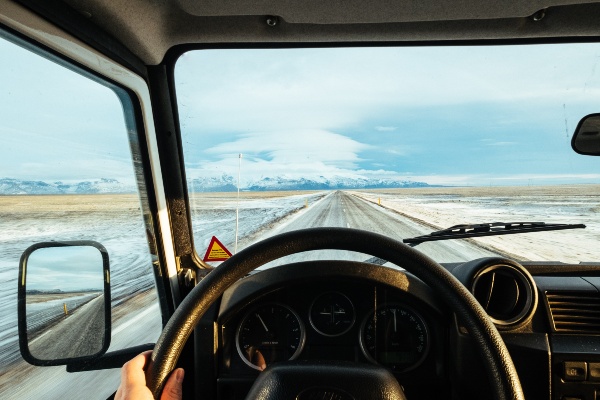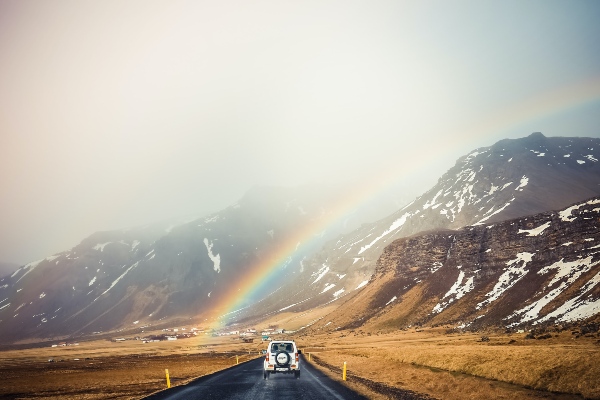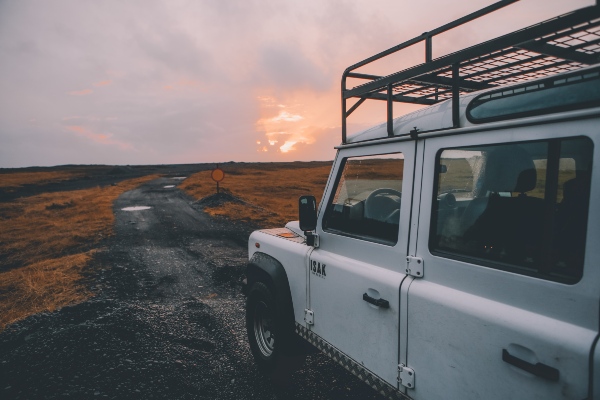Iceland is a place full of dramatic scenery comprising mighty glaciers, magical waterfalls, lush greenery and much more. With this in mind, it comes as no surprise that so many choose to visit here for a road trip of a lifetime.
Driving around Iceland provides the perfect opportunity to see all that this beautiful country has to offer. However, whenever you drive somewhere new, the roads, rules and regulations can take a little adjusting to. You must take some time to find out more about these to ensure that you keep yourself and everyone else safe when voyaging in Iceland.
If you’re planning a trip to Iceland, keep reading as we have all the necessary information you will need for driving here. Taking time to learn about the roads, signs, speed limits and more will help you make the most out of your time on this magical island.
Driving Laws and Regulations
It’s important to know your laws and regulations when driving in Iceland, as these may vary from the country you’re travelling from. The first thing to be aware of is that drivers operate on the right-hand side of the road here, so it’s best to get used to this before setting off on your journey!
Much like many other European countries, all passengers in the car must wear a seatbelt when travelling around Iceland. This is to protect all motorists and is vital as some of the roads here can be tricky to navigate, in particular the F-Roads – more about those later!
Something that differs slightly from other countries is that motorists are required to use headlights at all times in Iceland. The changing weather conditions can cause hazards when driving here, making it important for others to see you.
When travelling through Iceland, it can be tempting to stop off at the side of the road to admire the views or take photos. However, it is illegal to stop on the road, you must find a designated parking spot to stop safely.
Most of the roads in Iceland are either gravel or paved and you must stick to these. Detouring off the designated roads is illegal as this can damage the country’s beautiful, untouched landscape. So, enjoy all that this island has to offer whilst keeping the surroundings intact!
Another thing to remember when driving in Iceland is that you cannot use your mobile phone unless you have a headset. You will also be met with a significant fine if you are found to be operating a vehicle under the influence of alcohol. Committing any of these offences could ruin a trip of a lifetime, so it’s important to stick to the rules when navigating here to get the most out of your holiday in this lovely country.

Driving Safely in Iceland
It’s important to always be considerate of other road users in Iceland, make sure you give signals in enough time and stick to the speed limit. Travelling through a country full of stunning landscapes and beautiful scenery makes it hard not to get distracted, but you must keep your eyes on the road at all times. If you want to get a better look at the sights in Iceland, pull up in a parking spot and enjoy the view after you have stopped.
Unfortunately, much like driving in any other city, when moving through places like Reykjavik, you must be aware of what others are doing as well as yourself. Knowing your surroundings will help you drive safely through busier places, such as the capital.
When going on some of Iceland’s rugged roads, you must stick to what you feel comfortable with. Don’t feel pressured to go above the speed limit and never drive these roads in poor visibility.
Road Conditions to be Aware of
Iceland is renowned for its fierce weather conditions, so it’s always best to check this before setting off on your journey. Never travel if bad weather is expected, as this can make the road surface dangerous, alongside reducing your visibility.
When booking a road trip in Iceland, it is always best to hire a 4-wheel drive vehicle as these are better equipped for harsher weather conditions. When picking up your rental car, you can also speak to the rental company about expected weather, this will help you determine if it is safe to drive.
If you’re ever unsure, you can call 1777 between 6.30 am and 10 pm, this is the Public Roads Administration, and they will be able to offer better guidance for the weather and road conditions. Alternatively, visit www.road.is where you can find lots of information about driving in Iceland and the current road conditions.

Signage to be Aware of
You will find during your Iceland trip that the roads are generally well-signposted, making it much easier to find your way around. However, much like the other rules and regulations, these signs may differ from what you’re used to, so it’s best to brush up on the signs in Iceland before visiting.
Speed limits, road warnings and more are all things you should be aware of before driving in Iceland. Knowing these beforehand will help you navigate these roads far easier, limiting your chances of distraction.
Renting a Vehicle
Renting a vehicle is something that most tourists do when visiting Iceland. These vehicles are better equipped to drive on Icelandic roads, making them a safer alternative to using your car.
When hiring a car you must look into the rental company. See what vehicles they have available, preferably choose a 4×4 to get the most out of your road trip.
Make sure you ask questions like insurance and provide any necessary paperwork or ID that the company requires. Your rental car should also be in good condition when you take it. Check things like tyre pressure and your spare wheel before setting off in the vehicle.
Test driving the car beforehand is also a good idea as new cars can take some getting used to. This way you can come to terms with how the car drives before setting off on your journey.

Speed Limits in Iceland
One thing that would ruin your Icelandic road trip would be a hefty speeding fine! That’s why it’s important to know Iceland’s driving rules before setting off, this way you can stick to these and avoid getting into any trouble whilst visiting.
Iceland roads are typically categorised into three types, these are paved roads (or primary roads), gravel roads (secondary roads) and F-roads (highland roads/local access roads). The speed limits vary depending on what type of road you are travelling on. Below shows the average speed limit for each of these, so that you can drive here safely:
- Paved Roads – 90 km/h (55 mph)
- Gravel Roads – 80 km/h (50mph)
- F-roads – 50 km/h (30 mph)
You will also find speed signs along these routes, but being aware of these before your journey will help ensure you stick to the limit. Brushing up on your speed limits allows you to enjoy the ride, without having to worry about looking out for signage.
Driving License Requirements
Like any other European country, a driving license is required to drive in Iceland. Licenses issued in the EEA, UK and Japan are valid here. Any license issued outside of these places is allowed for up to six months after you arrive in Iceland.
You have to have held your license for a minimum of one year. For those choosing to travel to this beautiful country in a rental car, you also have to be 20 years or older. It’s worth noting that this age increases to 23 or older when hiring a 4WD vehicle.
The other thing to bear in mind is that depending on the country you are from, will determine whether or not your license is valid in Iceland. Below is an overview of some countries that can drive here using their license.
- United Kingdom
- Canada
- India
- China
- USA
- All European/EU licenses are valid
- Australia
- Malaysia
If your country isn’t on the list above you can find out more information here. Alternatively, you can contact the District Commissioner to discuss licenses and regulations. It’s always best to check whether or not you need an International Driving Permit when planning a road trip to another country. If you’re hiring a car in Iceland, your chosen rental company may also be able to offer more guidance.

Breakdowns and Repairs
When driving in another country, the thought of breaking down or needing repairs can be daunting. Not knowing the area, or where to get help is often a cause for concern for many motorists. Luckily, we have all the information you need so that you can visit Iceland well equipped for such instances.
Anyone choosing to hire a car in Iceland is generally in the best hands when it comes to breakdowns and repairs. Having a rental company on hand to help deal with such problems takes the stress away when on your road trip. The first thing you should do if you break down or need something repaired is to contact your hire car company. They will help support and guide you through the situation and assist in arranging necessary support.
For those choosing to travel to Iceland in their vehicle, it’s best to do your research before. Make sure you have a recovery company that can access you here. You can also cover yourself by packing an emergency kit for your journey. Including things like a warning triangle, fire extinguisher, reflective jackets, first aid kit and spare bulbs will all help in dealing with these situations.
F-Road Hazards
The F-roads in Iceland are notorious for being some of the trickier paths to navigate. Located in rural settings with bumpy routes and the potential river crossing, can create hazards for many drivers. However, the F-roads provide some of the most scenic journeys in the country, with mountain passes, glaciers, winding cliffs and much more.
Iceland’s changing weather conditions mean that the F-roads are only open for 4 months of the year. They are usually accessible in the summer, from the start of June until the end of September, although this can change depending on the climate at the time. Driving on these roads from October to May can increase your chances of hazards like slippery surfaces and crumbling road edges, so you must stick to the opening and closing times when visiting Iceland’s rural paths.
Another thing to consider when navigating Iceland’s F-roads is that there may be occasions where you have to cross rivers – just one of the reasons why 4WD rentals are advised! River crossings can vary from shallow, slow streams to fast-flowing, deep water. You should always check the water before attempting to drive through and bear in mind that it will always be deepest in the middle. Wider rivers are also more hazardous. As you wade through the water, it can create waves in front of your vehicle, which can cause you to become stuck.
Despite the hazards associated with F-roads, as long as you consider all risks, you will find an adventure like no other. With opportunities to see some of the more secluded parts of the island, plus hair-raising journeys through rivers, winding paths and more, this is one part of Iceland certainly worth experiencing!

Summary
We hope that after reading through our recommendations for driving in Iceland, you can now visit well-equipped with all this information in mind. All visitors must leave the country as they found it, this way everyone can enjoy the beauty and natural scenery that Iceland has to offer.
If you’re planning to visit Iceland to make the most of its magnificent landscapes, you’re likely in need of transport. Take a look at our fantastic range of vehicles available to rent for all kinds of holidays in Iceland.
